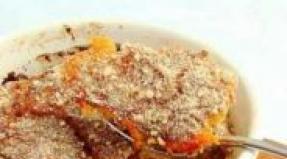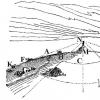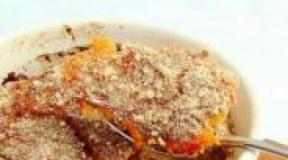Beginning of the reign of Louis XIII of France. Louis XIII and Cardinal Richelieu Louis 13 and Richelieu
It just so happens that we know much more about Anne of Austria, the wife of Louis XIII and the mother of Louis XIV, than about other French queens. This is mainly the merit of Alexandre Dumas, who dedicated his most famous and most successful series of novels - about the musketeers - to the "age of Louis the Great", and described not only the "magnificent four" in sweeping, bright colors, but also the historical figures of that time - the weak-willed Louis XIII, the “real monarch” Louis XIV, the intelligent, energetic and ruthless Richelieu, the stingy rogue Mazarin, the proud and beautiful Anne of Austria. Moreover, when handing out these characteristics, Dumas took very little account of reality - for him, History was just a mannequin that he dressed in the right clothes - to his liking. And his “historical” heroes are in fact only shadows, or even caricatures of themselves. Richelieu was especially unlucky in this sense. A brilliant politician, a great statesman, comparable only to De Gaulle in terms of the importance of what he did for France, he appeared in the novel as an evil intriguer, only thinking about how to quarrel between the crowned spouses. Anna of Austria, on the contrary, was lucky - an ordinary, easily influenced princess with a difficult fate, thanks to Dumas' talent, she became a real romantic heroine. Diamond pendants, the love and death of Buckingham, the jealousy of the king and the hatred of the cardinal - what are not the attributes of the life of the fatal beauty, whose son became the most famous French monarch?
In fact, the fate of Anna of Austria was not nearly as romantic as Dumas would have liked, although no less rich in adventures. Ana Mauricia, the eldest daughter of the Spanish King Philip III, was born in 1601 to the most stingy, gloomy and religious court in Europe. At that time, the wealth and power of the “empire where the sun never sets” began to slowly dwindle. Ana's father was too weak a king to hold power in his hands, and all affairs were run by his first minister, the Duke of Lerma. Lerma did not spare money for his pleasures, but his royal family lived like a Spartan. True, in Spain they believed that children should be raised in severity, piety and deprivation. This is how princes and princesses received “combat training”, after which even life in a monastery seemed idle and luxurious to them.
Ana never received a decent education. At that time, it was customary to teach princesses only Latin and the basics of European languages, and they had to spend the rest of the time in prayer. Eating something tasty or dressing smartly was only supposed to happen on very big holidays. Usually infantines wore black, bulky and monstrously uncomfortable dresses, they were not allowed to run or play (idleness at the Spanish court was considered a grave sin), and their every action was sternly monitored by duennas.
The children even saw their parents only on the days established by the regulations. Only Philip III could break it, but he had almost no interest in the kids. His wife, Queen Margaret, lived in conditions no less harsh than her daughters. Married at the age of 15, she gave the king another offspring almost every year, and during ten years of married life she hated everything - her rag husband, who was spun by the minister, the minister himself, who bathed in luxury, while she had to almost starve, the sanctimonious Spanish court, mired in intrigue... "It is better to be a simple nun in Austria than the Spanish queen!" - she complained to the Austrian envoy. The Queen died at the age of 27, almost happy that she was getting rid of the life she hated.
By that time, Anya was not even ten, but she was already betrothed to the Austrian Prince Ferdinand. The prince was her cousin, but this did not bother the parents of the bride and groom: the Habsburgs were accustomed to entering into marriages “between their own”, without being interested in what consequences this could lead to. But Anya was lucky. In 1610, in neighboring France, the “face of the state” changed, and instead of the murdered Henry IV, who was at enmity with Spain, power was given to his wife Maria de Medici, a devout Catholic who longed for friendship with the “first Christian power of the world.” According to the custom of that time, the political union was sealed with a dynastic one: 10-year-old Infante Philip married one of the French princesses, and 14-year-old Ana married her peer, young Louis XIII.
Young Louis 13th
At first, no one doubted that Louis and Ana (who became Anna) would be a friendly and loving couple. The young queen was rightfully considered the most beautiful princess in Europe, and the king (who, by the way, was also good-looking) was ready to blow away specks of dust from her. But Anna was still too young to appreciate it. Having found herself from prim Madrid to brilliant and wasteful Paris, she plunged headlong into the whirlpool of pleasures and cheerful antics that were looked at so askance in Spain. And since her husband was a gloomy loner, the queen found herself another playmate - the younger brother of King Gaston of Orleans, smiling, elegant, witty, and much more suited to her character. Perhaps Louis would not have taken his wife’s friendship with his brother to heart, but his mother constantly hinted that Anna was a fidgety girl and needed an eye on her. The mother-in-law was of little interest to her daughter-in-law's morality - she was simply afraid that Anna would begin to command her weak-willed husband and deprive her of power.
Maria Medici
Gaston d'Orléans
In 1617, the Queen Mother was removed from power - without any participation from Anne of Austria. Nevertheless, the Medici did not deny herself the pleasure of planting a “time bomb” under her son’s marriage. She left at court the daughter of the Duke de Montbazon, a spectacular blonde, the first beauty of France. The Queen Mother hoped that Louis would not be able to resist the charms of an experienced coquette beyond his age - and she was wrong. The king despised overly active women. He married de Montbazon, who was becoming his favorite, to his first minister, de Luynes, and when he died, he advised the widow to leave for the provinces. The king had no idea what a dangerous enemy he had made for himself in the person of the offended beauty. Less than six months later, the widow married the Duke de Chevreuse, returned to court and became the beloved friend of Anne of Austria.
Madame de Chevreuse
It was she who lured the 24-year-old queen into a love affair, for which Anne had to pay dearly - the story with the Duke of Buckingham. The all-powerful favorite of the English king arrived in France in 1625 - and was conquered by the beauty of the wife of Louis XIII. To impress her, the 32-year-old Duke squandered money and was ready for any madness. He charmed the bored Anna of Austria without difficulty. But, having received a strict Castilian upbringing, the queen gave her admirer a maximum of admiring smile. This was not enough for the first dandy of Europe, who changed lovers like gloves. He was ready to spend half the money of the English crown so that Anna's favor would be expressed in something more significant.
George Villiers, Duke of Buckingham
In the person of the Duchess de Chevreuse, Buckingham found a faithful ally. She was ready to spend hours telling the queen about the beauty and generosity of the Englishman, slowly persuading her to give her admirer a “minute audience.” Finally, at a celebration in the Amiens gardens, Anna succumbed to temptation and allowed de Chevreuse to take her for a walk along one of the dark alleys. A few minutes later, a noise was heard from the alley along which the queen had retreated. The courtiers and servants who came running witnessed an unprecedented spectacle: Her Majesty was very energetically breaking free from the embrace of the English guest.
The scandal became the property of all of Europe. The next day, the Duke was forced to leave France, and Anna of Austria was forced to give explanations to her husband. In fact, everything that happened testified rather in her favor, but it was impossible to convince the angry Louis of this. The relationship between the spouses, which by that time was already cool, deteriorated completely.
Anna considered the new first minister, Armand du Plessis, Cardinal Richelieu, to be the culprit of her husband’s unabated rage. Contrary to what Dumas wrote, the conflict between the queen and Richelieu was purely political. The minister pursued an “anti-Spanish” line in politics, and this, of course, did not suit the sister of the Spanish king. In addition, being a devout Catholic, Anna could not understand how the prince of the church could be an ally of German Protestants in the war against her cousin, the Catholic emperor. And since the concept of “interests of the state” at that time was not in honor among the nobility, only one conclusion suggested itself: Richelieu is her personal enemy who wants to destroy her.
Richelieu
From now on, Anne of Austria and her faithful de Chevreuse participated in all conspiracies against the cardinal. These conspiracies, as a rule, ended in failure: the queen and the Duke of Orleans had to justify themselves, the Duchess de Chevreuse had to hide abroad, and less noble intriguers had to pay with their heads. However, Richelieu repeatedly proved that he could take revenge, despite his nobility. Participation in one of the intrigues cost the life of the Duke de Montmorency; another conspiracy forced Louis XIII to expel his own mother from the country, who died in Cologne almost in poverty.
True, Richelieu spared Anna of Austria. Although it was easiest for him to get even with her: ever since the scandal with Buckingham, divorce had been His Majesty’s cherished dream. But the cardinal understood what the offended husband did not want to hear about - the Pope would hardly have given his consent to the dissolution of the marriage, which means Louis would not have been able to marry again. France needed an heir, and not such a nonentity as Gaston of Orleans, who betrayed all his friends and lived on handouts from the Spanish king. Richelieu had little choice, and he hoped that Anna would wise up and finally give birth to a son for the king.
Louis 13th
It took several years to persuade His Majesty to forgive his wife, and Richelieu even involved the monarch’s retired favorite in this. Finally, Louis succumbed to a moment of weakness, and after the allotted time, all of France celebrated the birth of the Dauphin. True, even then rumors spread that the king had been deceived, and the boy born was not his son at all. But there was no serious “evidence” against the queen - especially since Richelieu, who was in dire need of an heir, did not try to look for it. Louis was so happy about the birth of his son that for some time he made peace with his wife, as a result of which another prince was born - Philip of Anjou.
By that time, Anna had reconsidered her attitude towards Richelieu and realized that the cardinal was more likely her ally than her enemy. This was facilitated by the talented politician whom Richelieu chose as his successor - Giulio Mazarin, a handsome, although not very noble Italian, who from the late 30s became the queen's lover. It was Mazarin who convinced Anna that with her intrigues against the cardinal she was helping others - but not herself. The queen corrected herself and “surrendered” another conspiracy to Richelieu, providing evidence that proved the treason of the king’s brother.
In response, Richelieu tried his best to reconcile the crowned spouses. Alas, to no avail: the king not only did not want to hear about his wife, but also slowly began to hate his own son. The death of the cardinal in 1642 put Anna's freedom, and even her life, in jeopardy - now nothing stopped Louis from imprisoning the queen in a monastery. But Anna of Austria was lucky: just six months after the death of the cardinal, her husband fell ill and died suddenly, without even leaving sensible orders regarding the regency.
Thanks to Mazarin, the regency and power went to Anna. True, the country was uneasy: the Fronde was raging, a rebellion of princes who dreamed of driving away the “Spanish flu and the Italian,” eliminating the young king and elevating the weak-willed Gaston of Orleans to the throne. The queen was saved only by the fact that her political enemies often adhered to different goals and constantly moved “from camp to camp” - either on the side of the queen or on the side of the rebels. Anna and Mazarin took full advantage of this: they flattered, persuaded, promised mountains of gold, arrested, threw in prison, executed... The Queen was infinitely grateful to her first minister. After all, it was Mazarin who eventually brought order to the country, ended the Thirty Years' War with Spain, and advantageously married the young king to the infanta. Dying, the cardinal left Louis XIV a peaceful and prosperous kingdom.
Mazarin
After Mazarin's death, Anna retreated into the shadows. She did not get along very well with the arrogant and selfish Louis and preferred the company of his affectionate and caring younger son to him. Having lived a stormy life, the queen, even in old age, was very pretty and looked much younger than her years. In 1666, she died in the arms of the inconsolable Philippe d'Orléans, who, ironically, looked like Louis XIII.
The Spanish infanta, French queen, regent and mother of Louis XIV, Anna of Austria never thought about how she would remain in the memory of her descendants. She could not even imagine that two hundred years after her death, the novelist of all times Alexandre Dumas would give her something that life does not spoil even queens - eternal youth and beauty, a beautiful and noble lover, as well as four devoted knights of cloak and sword, ready to die for her life, honor and love - Athos, Porthos, Aramis and d'Artagnan.
- (Louis XIII) LOUIS XIII (1601 1648), king of France, son of Henry IV and Marie de' Medici, was born at Fontainebleau on September 27, 1601. After Henry was killed on May 14, 1610 by a religious fanatic, Louis ascended the throne, but before he reached … … Collier's Encyclopedia
King of France (1610 1643), son of Henry IV and Marie de Medici; genus. in 1601. During his childhood, his mother, as regent, retreated from the policies of Henry IV, concluding an alliance with Spain and betrothing the king to Infanta Anna. This raised concerns...
Louis XIII of France Louis XIII portrait by Rubens, 1625 ... Wikipedia
Louis XIII of France Louis XIII portrait by Rubens, 1625 ... Wikipedia
Louis XIII of France Louis XIII portrait by Rubens, 1625 ... Wikipedia
Louis XIII of France Louis XIII portrait by Rubens, 1625 ... Wikipedia
- (Louis the Just, Louis Le Juste) (September 27, 1601, Fontainebleau May 14, 1643, Saint Germain en Le), king of France from 1610 from the Bourbon dynasty (see BOURBONS). The eldest son of Henry IV (see HENRY IV of Bourbon) of Navarre and his second wife Maria de Medici... encyclopedic Dictionary
King of France from the Bourbon dynasty, who reigned from 1610 to 1643. Son of Henry IV and Marie de' Medici. J.: from November 25, 1615 Anna, daughter of King Philip III of Spain (b. 1601, d. 1666). Genus. 27 Sep. 1601, d. May 14, 1643 According to... ... All the monarchs of the world
King of France (1610 1643), son of Henry IV and Marie de Medici, b. in 1601. During his childhood, his mother, as regent, retreated from the policies of Henry IV, concluding an alliance with Spain and betrothing the king to Infanta Anna. This raised concerns... Encyclopedic Dictionary F.A. Brockhaus and I.A. Efron
Books
- Louis XIV and his century. In 2 volumes, Dumas Alexander. The French king Louis XIV of the Bourbon dynasty ruled France for 72 years. These years are called the century of Louis, and the era of his reign is called the time of absolute monarchy. Nevertheless, about the person...
- Cardinal Richelieu. Louis XIII, Kondraty Birkin. Kondraty Birkin is the pseudonym of the famous Russian historian of the 19th century. Pyotr Petrovich Karatygin, the author of works popular among his contemporaries, mystical and historical novels, which became...
Louis XIII Bourbon - (born September 27, 1601 - death May 14, 1643) - King of France and Navarre Louis 13, nicknamed the Just, ruled from 1610 to 1643. Son of Henry IV (the first king of the Bourbon dynasty) and Marie de Medici.
Young King
After his father Henry IV was assassinated, Louis ascended the throne at the age of eight. The rule passed to the mother, Maria de Medici as regent, and her favorite, the Italian Concino Concini, who is known in history as Marshal d'Ancre. Maria paid almost no attention to the young king and did not give him any education.
The only person who remained close to Louis for many years was his uncle Albert de Luynes. He especially pleased the Dauphin with his extensive knowledge of training dogs and training falcons for hunting. Louis became so attached to him that he did not let him go even for a minute.
End of the reign of Marie de' Medici
1614 - the king was declared an adult, but even after that power remained in the hands of Maria de Medici and her favorite. The young monarch, not knowing how to get rid of the hated dAncre, on the advice of Luynes, decided to kill the marshal. The murder was entrusted to the guard captain Vitry. On the morning of April 24, 1617, Vitry and three other accomplices met the favorite in one of the Louvre corridors and shot him at point-blank range with a pistol. A legend has survived to this day that, having learned about this, the king joyfully exclaimed: “This is the first day of my real rule!”

He ordered Maria de Medici to convey that, as a good son, he would continue to respect her, but from now on he would rule the country himself. The mother retired to Blois. In fact, the king had neither the mind nor the desire to engage in state affairs himself. From dAncre power passed to de Luynes. His death in 1621 opened the way to the throne, who at first was a simple member of the royal council, but then very quickly was able to advance to the position of first minister.
Reign of Cardinal Richelieu. Intrigue
In his policy, Richelieu pursued 2 main goals: he tried to crush the power of the nobility and calm the Huguenots. Both there and here he was able to achieve complete success. 1628 - La Rochelle, which for many decades was considered the support of their power, was taken from the Protestants, and other fortifications were destroyed. Thus, the separatist aspirations of the Huguenots and their dreams of creating their own republic, independent of the monarch, came to an end forever.
In the same way, the nobility received a terrible and ruthless enemy in the person of Richelieu. While fighting his enemies, he did not disdain anything: denunciations, espionage, gross forgeries, deceit unheard of in former times - everything was used. The Cardinal effortlessly destroyed conspiracies drawn up against him, while his personal intrigues usually ended in the execution of one or more of his enemies.

Many brilliant representatives of the French aristocracy ended their lives on the scaffold at that time, and all pleas to Louis for their pardon remained unanswered. The king generally knew how to hate strongly, but he always loved carefully. He was cruel by nature and suffered more than many other rulers from the usual royal vice - ingratitude. The aristocracy trembled with horror and indignation, but in the end had to bow to the power of the cardinal.
The king's mother and some of his brothers plotted against Richelieu and the king himself. 1631 - Richelieu managed to uncover a conspiracy against the monarch. The goal of the conspirators was to kill Louis and seize power. After this, the monarch began to unconditionally trust the cardinal, giving him complete freedom of action.

Hobbies of Louis XIII
In private life, the king did not show much inclination towards pleasure - nature made him pious and melancholic. Like many Bourbons, he loved manual labor: he wove nets, repaired gun locks and even forged entire guns, masterfully minted medals and coins, raised early green peas in a greenhouse and sent them to sell at the market, knew how to cook some dishes and shaved perfectly ( Once, while amusing himself with his barbering skills on the beards of officers on duty, he came up with the then fashionable royal beards).
Not every European monarch could say about himself: “The State is me.” However…
Women never played a big role in the life of the monarch. Back in 1612, after concluding a friendly treaty with Spain, Maria de' Medici and Philip III agreed to seal the alliance with a marriage between the two royal dynasties. Louis was then betrothed to the Infanta Anna, although both he and she were still children. 1615, November - the wedding took place. Due to the youth of the spouses, their marital duties were postponed for 2 years. Anna of Austria soon realized that her marriage would not be happy. The gloomy and silent Louis stubbornly preferred hunting and music to her company. He spent whole days either with a gun or with a lute in his hands.
The young queen, who went to Paris with the hope of a cheerful and joyful life, instead found boredom, monotony and sad loneliness. After an unsuccessful wedding night, Louis decided to get closer to his wife again only 4 years later. This time his experience was successful, but several pregnancies ended in miscarriages. The king began to neglect the queen again. For some time it seemed that he would not leave an heir. However, after that almost a miracle happened, and in 1638 Anna of Austria, to the great joy of her subjects, gave birth to the Dauphin Louis (future). This important event happened at the end of the reign. Five years later, Louis began to suffer from stomach inflammation and died while still a relatively young man.
Despite the many beautiful seductive women, the king...
According to the testimony of contemporaries, from childhood Louis showed bad inclinations that were not characteristic of either his father or mother. His main shortcomings were spiritual callousness and hard-heartedness. As a child, playing hunting in the palace garden, the Dauphin loved to catch butterflies to tear them into pieces, and plucked the feathers of the caught birds or broke the wings. Once, the compassionate Henry IV caught his son playing such fun and personally whipped him.
The young monarch did not fulfill his marital duties. As Robert de Montesquieu said, the king’s entourage came up with a ruse, deciding to show Louis what the process of love consists of. They led the young man into a secret room, in which his sister, the Duchess of Vendôme, and her husband staged a visual demonstration. While the king watched, his doctor and confessor were next to him. After the doctor noted the physical changes in the young king’s condition caused by this performance, he immediately sent Louis to bed, where Anne of Austria was waiting for him, suitably prepared. The performance was a success, which was very strange in view of the fact that all the “conspirators” were present in the royal bedroom, observing the correctness of his actions.
From childhood, Louis discovered evil inclinations that were not characteristic of either his father or mother. He was callous and hard-hearted. For example, the Dauphin loved to play hunting in the palace garden. He caught butterflies and tore off their wings, and pulled out the feathers of caught birds and broke their wings. Once, the compassionate Henry IV caught his son doing this and whipped him with his own hands.
Portrait of Louis XIII in 1611 by Pourbus, France the Younger, (Palazzo Pitti)
Louis was eight years old when his father fell at the hands of an assassin. The affairs of the board passed to the mother, Maria de Medici, and her favorite, the Italian Concino Concini, known in history as Marshal d'Ancre. The mother hardly cared for the young king and did not give him any education. For many years, the only person close to Louis was his uncle Albert de Luynes. He especially pleased the Dauphin with his deep knowledge of training dogs and training falcons for hunting. Louis became so attached to him that he could not let him go even for a minute.
The king was declared an adult in 1614, but even after that power remained in the hands of the Queen Mother Maria de Medici and her favorite. The king, not knowing how to get rid of the hated D’Ancre, decided, on the advice of Luynes, to kill the marshal. The execution of the plan was entrusted to the guards captain Vitry. On the morning of April 24, 1617, Vitry and three accomplices met the favorite in one of the Louvre corridors and shot him point-blank with a pistol. There is a legend that, having learned about this, Louis joyfully exclaimed: “This is the first day of my real dominion!” He told his mother to tell her that, as a good son, he would continue to respect her, but from now on he would rule the state himself. Marie de' Medici retired to Blois. In reality, the king had neither the mind nor the desire to deal with the affairs of government himself. From d'Ancres, power passed to de Luynes. His death in 1621 opened the way to the throne for Cardinal Richelieu, who at first was a simple member of the royal council, but then very quickly rose to the position of first minister.

Portrait by Rubens, 1625
In his policy, Richelieu pursued two main goals: he tried to crush the power of the nobility and calm the Huguenots. And he accomplished both goals. In 1628, La Rochelle, considered the pillar of their power for many decades, was taken from the Protestants, and other fortifications were destroyed. Thus, the separatist aspirations of the Huguenots and their dreams of creating their own republic, independent of the king, came to an end forever.

Cardinal Richelieu
The French aristocracy, following the Huguenots, found a ruthless enemy in the cardinal. Richelieu did not disdain anything: denunciations, espionage, gross forgeries, previously unheard of deceit - everything was used. The Cardinal was a master of, as they would say now, a multi-move move. He easily, as they would say now, outplayed his opponents: he destroyed the conspiracies drawn up against him. Richelieu’s own intrigues ended extremely badly for his enemies - execution. Many brilliant representatives of the French aristocracy ended their lives on the scaffold in those years, and all pleas to the king for their pardon remained unanswered.
Louis generally knew how to hate strongly, but he always loved carefully. He was cruel by nature and, more than many other monarchs, suffered from the usual royal vice - ingratitude. The aristocracy trembled with horror and indignation, but in the end had to bow to the power of the cardinal.
,%20%D0%A4%D0%B8%D0%BB%D0%B8%D0%BF%D0%BF%20%D0%B4%D0%B5%20%D0%A8%D0%B0%D0%BC%D0%BF%D0%B0%D0%BD%D1%8C.jpg)
"Louis XIII, crowned by Victoria (to the siege of La Rochelle)", Philippe de Champagne
In private life, Louis showed little inclination towards pleasure - nature made him pious and melancholy. Like many Bourbons, he loved manual labor: he wove nets, repaired gun locks and even forged entire guns, masterfully minted medals and coins, raised early green peas in a greenhouse and sent them to sell to the market, knew how to cook some dishes and shaved perfectly (once, amusing himself with the barber's skill on the beards of officers on duty, he came up with the then fashionable royal beards).
In addition, the king loved music. From the age of three, the Dauphin played the lute; Louis considered it the “queen of instruments.” He also loved the harpsichord and masterfully handled the hunting horn. He beautifully sang the first bass part in the ensemble, performing courtly songs and psalms. In 1610, Louis made his debut in the court “Ballet of the Dauphine”. He usually performed noble and grotesque roles in court ballets, and in 1615, in “The Ballet Madame” he played the role of the Sun. Louis XIII also composed songs. His music was performed in the famous Merleson Ballet, for which he composed dances, created costumes and performed several roles himself.

“Large ceremonial portrait of King Louis XIII”, Philippe de Champagne
Women never played a big role in the life of Louis XIII. Back in 1612, after concluding a friendly treaty with Spain, Maria de Medici and Philip III agreed to seal the alliance with a marriage between the two royal families. Then Louis was betrothed to the Infanta Anna, although both he and she were still children. The wedding took place in November 1615. Due to the youth of the spouses, their marital duties were postponed for two years. Anna of Austria soon realized that the marriage would not be happy. The gloomy and silent Louis stubbornly preferred hunting and music to her company. He spent whole days either with a gun or with a lute in his hands. The young queen, who went to Paris with the hope of a cheerful and joyful life, instead found boredom, monotony and sad loneliness. After an unsuccessful wedding night, only four years later the king decided to get closer to his wife again. This time his experience was successful, but several pregnancies ended in miscarriages. Louis again began to neglect the queen. For some time it seemed that he would not leave an heir. But then almost a miracle happened, and in 1638 Anne of Austria, to the great joy of her subjects, gave birth to the Dauphin Louis (the future Louis XIV). This important event occurred at the end of the reign. Five years later, the king began to suffer from stomach inflammation and died while still a relatively young man.
Favorites of the French kings. At the court of Louis XIII. "Poor Louis."The figure of this Louis is ambiguous and his character is contradictory... Analyzing all the historical chronicles, I ask myself the question: Did the guy sincerely love someone, all the problems and misunderstandings come from childhood, as you know...
And the fate of Louis himself and his wife Anna lived in parallel worlds, but this is my opinion... you decide

Portrait of Louis XIII in 1611 by Pourbus, France the Younger, (Palazzo Pitti).
As a child, he had a governess, Madame de Mongla. And so, there was this personal doctor and nurse. These are the people who surrounded him. It must be said that the queen turned out to be a bad mother. Firstly, it was accepted that the child was raised not by the queen, but by some specially appointed people. But Anna of Austria, for example, behaved differently towards her son, after all, she was still in his life as a mother. Maria de Medici no, she didn’t love him at all. And there is plenty of evidence that she did not want to see him.

Portrait en buste de Louis XIII à 10 ans, Peint au Louvre en 1611
She didn't come to him when he was sick. Despite the fact that he loved her very much in childhood, as most often happens: children are very drawn to their mother, and it rarely happens that a child does not love his mother. The mother was practically absent, only in official, representative functions. This cannot be said about his father; his father seemed to love him, and the only kindred tenderness that he received was the tenderness of his father. But his father was a peculiar person. As a child, he was raised in a simple way, he was flogged, and he believed that this was good for him.

Monogram of the king Louis XIII in the western half of the northern side of the Cour Carrée du Louvre

In general, to be honest, if the Gascons and Béarnians don’t hear, then this Bourbon courtyard is some kind of chicken coop, such a nice village courtyard. Henry IV believed that if it benefited him, it would benefit his son too. And from the age of two (imagine!) this boy was flogged with rods in order to calm him down, in order to break his stubbornness (little children are often stubborn, right? They both want something and achieve something). So, they subdued him with rods. And this happened very often, almost every day, because the boy, apparently as a result of such upbringing, showed more and more stubbornness, disobedience, etc.

Maria de" Medici and her son Louis XIII by Charles Martin
And there was one more thing that was very unpleasant for the boy. It is known that Henry IV was a womanizer, as you said. He had many women. Moreover, he was not at all embarrassed by the fact that this was in front of everyone, these women were in the same palace, everyone knew everything perfectly well. From each of these women he had children, so he had a lot of children, he recognized all of them as his own, it was also known to everyone that these were royal children - the Dukes of Vendôme and all sorts of other marquises.

Henri IV, the royal family and Fouquet of Varenne
They were all raised together, and these women surrounded these children. That is, small children also knew all this very well. Yes, this is also okay - although this caused great difficulties for the children: they were jealous of each other. Little Louis did not like them all very much. But that’s still okay. The whole point is that Henry IV did not at all consider it necessary to hide his sex life from the boy, in the literal sense: he not only explained everything and showed everything, on purpose, he believed that this should be done. And thus, this little boy (it was probably the same with others, we just don’t know about them, but we know very well about this one) from a very early age was deprived of childhood innocence, ignorance.
And this had a very bad effect on the development of his child’s psyche in the future. It is known that already at the age of 5-6 he was afraid of his sister. He was generally afraid of girls. Well, naturally, this should have affected his future male life. This was his childhood. He had a very strict nanny, a governess, who was not at all afraid to spank him, and did it quite often, especially since his father insisted on it.
And indeed, we know that the boy very often showed aggressiveness at an early age. And it was such aggressiveness... the king loved to tease him. There is a known case when the king tore off his hat and put it on himself. The boy did not like this very much (he was a very small boy, he was three and a half years old), he began to demand that the king give him this hat. And the king took away something else from him... a drum there, some sticks, and the boy literally went crazy, he was hysterical. Then we will read in the diary (Eruard was the name of this doctor) that in his youth, in his young years, he had such convulsive seizures, which later gave researchers reason to say that he had epilepsy.

Louis XIII enfant, par François Rude, Musée des beaux-arts de Dijon
In general, when he was born, the doctor writes that he was such a strong, healthy boy, although he had a small tongue defect: on the second day of his life, the frenulum under his tongue was cut. But in general, he was a very healthy child, but such upbringing led to the fact that already in his young years he began to get sick, he began to have such psychosomatic disorders, when some kind of dysfunction of organs begins, associated with very strong neurosis.
Louis XIII enfant, sculpture de François Rude en 1878, exposé au Musée des beaux-arts de Lyon
And then he developed inflammation of the intestines, which accompanied him all his life, and he suffered terribly from it. Then, in his mature years, since the body was weakened by this constant digestive disorder, it is believed that he died of tuberculosis, he developed tuberculosis. He died at 42 years old. In our opinion, he is still a young man.
His father Henry IV was killed quite unexpectedly in 1610, when the boy, as we understand it, was 9 years old. And Queen Mother Maria de Medici became regent. She was very happy about this fact that finally, firstly, she was freed from her husband, who humiliated her with his behavior (she was very dissatisfied with him, naturally). And she felt free, felt in power. Around her were people like Concini, this Italian adventurer, who had recently married his beloved friend Maria de Medici, her childhood friend. And this couple - the Concini family - completely subjugated the queen to their influence, and they ruled over such a trio.
Louis continued to be flogged, I must say, for a long time. Look, he is a king, and he is being flogged. In addition, it is practically not taught. And even when he began to grow up, this Concini couple (if such evidence exists) deliberately deprived him of the necessary education, because they were interested in him being as late as possible and as less able as possible to actually ascend to the throne, to actually become a king.
They were interested in ensuring that the regency lasted as long as possible. And, by the way, in France, kings, in any case, reached maturity at the age of 13. And officially, when I turned 13, the regency officially ended. Of course, a child of 13 years old cannot yet rule a kingdom, this is clear. So the boy was taught very poorly, he received only what was absolutely necessary education, that is, he was taught to read, write and Sacred History. He did not receive the real systematic education that Richelieu received, for example, at his Paris college at all.
At the same time, again, Eruard’s evidence, first of all, suggests that he was a capable boy. Firstly, he showed a sharp mind, such an ironic mind even in early childhood. He learned to write and read very early, by the way. He loved to draw, did it willingly and was very willing to learn it. He was very willing to learn music and even as an adult, he composed music. That is, apparently, he was a man of such a right-hemisphere type, as intuitive as people of art are, but some more exact sciences interested him less.
However, he was not taught them much. He was taught very poorly. And what these high-ranking political educators taught him, indeed, very well, was hunting. This is what they made sure that he studied properly and did. They believed that the king should hunt. They assigned him the Count de Luynes, they believed that this was a very simple man, incapable of any intrigues against them, and so he was made such a teacher of the young king.
But they miscalculated in the sense that Luynn turned out to be a different person in fact, Louis became very attached to him, he was his most beloved person at that time. Well, some other people were found near the king. And when the boy was 16 years old, he finally took the royal power for himself. With the help of his entourage, he organized the murder of Concini, his mother's closest friend, his wife was then executed, and the queen regent was removed from power.

Young Louis
And from this moment it is believed that Louis XIII truly assumes his powers. And then it turns out that he is completely incapable of ruling the state. And, apparently, he himself is aware of this, because he very actively begins to get involved in government affairs, delve into everything, try to do something. Look for advisers, despite the fact that he is a 16-year-old boy. Of course they are in charge. But at this moment, when he realizes himself as a person who must govern his state, must govern the country, here he begins, by the way, to learn and gain some knowledge and some opportunities, including select people who would allow him to do this.

Louis XIII
In this case, the person really carries his cross, with which he was born. And, by the way, Louis XIII perceived this precisely as a cross that he must bear, since it was entrusted to him by the Lord. He was a very religious man, and he carried this cross all his life, trying to do it in the way he considered worthy of doing it. And, in general, he succeeded. Although, of course, all sorts of things happened during this reign.

Claude Lorrain - Siège de La Rochelle par Louis XIII. 1628
But when I consider childhood, upbringing, where all these kings came from, more or less worthy or completely unattractive, like, say, Louis XV, when you consider where this came from, the optics somehow change. You see that, indeed, it could have been even worse. Louis XIII, of course, was a tragic figure, because he had all this that was in him, that he carried from his childhood, in adulthood he learned to restrain, he learned to restrain his aggression, he learned to restrain his various kinds of impulses and various kinds needs. But this restraint led to the fact that, of course, constantly retaining some feelings and some complexes within himself led to self-destruction, so he did not live long.

Wax King at Madame Tussauds

Maria de' Medici pursued a pro-Spanish policy.At the end of 1615, 14-year-old Anne of Austria arrived in France and on October 18 married Louis XIII. At first, the king was fascinated by his wife, who was deservedly considered the first beauty of Europe, but after a while it turned out that the young couple were completely unprepared for family life. Their relationship cooled more and more every year. Anna was prone to betrayal and intrigue, and in addition tried to pursue a pro-Spanish policy in France. The Queen supported conspiracies against Richelieu.
The king paid more attention to his favorites than to his wife. In 1617, the place of the main favorite was taken by Charles Albert de Ligne. At his instigation, the king, removing his mother from business, sent her to Blois, and Marshal d'Ancre was killed.

"Wedding of Louis XIII of France and Anne of Austria"
Louis was a passionate music lover. From the age of three, the future king played the lute, considering it the “queen of instruments,” as well as the harpsichord; masterfully wielded a hunting horn and sang the first bass part in the ensemble, performing polyphonic courtly songs (airs de cour) and psalms.

Jean Chalette Marriage de Louis XIII Toulouse..
He began to study dancing from childhood and in 1610 he officially made his debut in the court “Ballet of the Dauphine”. Louis performed noble and grotesque roles in court ballets, and in 1615 he played the role of the Sun in “The Ballet Madame.”
Louis XIII is the author of courtly songs and polyphonic psalms; His music also sounded in the famous “Merleson Ballet” (1635), for which he composed dances (“Symphonies”), designed costumes, and in which he himself performed several roles.
In 1619-1620, Maria de Medici tried twice to overthrow her favorite, but failed. In August 1620 she established contact with Louis XIII through Richelieu. In 1621, de Ligne died, and unrest began among the Huguenots in the south of France. Louis XIII personally took part in the hostilities. He willingly used the advice of Richelieu, who was appointed cardinal in September 1622.

Armand Jean du Plessis, Duke of Richelieu
In 1624, Richelieu became the first minister, and the king, who suffered from many illnesses and bouts of melancholy, entrusted him with the management of the country. Richelieu, having completely broken with the Queen Mother, abandoned pro-Spanish politics. Thanks to many historical novels (primarily by A. Dumas the Father), the stereotype about Richelieu’s “dictatorship” and a weak-willed king was strengthened in society, but numerous sources indicate the opposite.

Louis XIII Crowned by Victory by Philippe de Champaigne (Louvre INV 1135)
There was no dictate from the cardinal. And the relationship between the king and his first minister, although it was not smooth, was not the same as Vigne and Dumas described it. With the arrival of Cardinal Richelieu, the king's foreign policy began to change, but this happened gradually.

Throne Room at Fontainebleau
From the government's point of view, first of all it was necessary to restore order within the country, which meant reconciliation (or pacification, depending on the circumstances) of opponents of strong royal power, which were not necessarily exclusively Huguenots. But it was the latter who found themselves at the edge of the cardinal’s sword, since the Huguenot party decided to take advantage of external support in the person of Spain and England. By the end of the 1620s, the Huguenots were pacified, and a special royal edict regulated the religious and political rights of Protestants within the country.

Grande salle du Palais-Cardinal c1642 engraving Le Soir by van Lochun - Holsboer 1933 plate6
Created: 1 January 1642
At the same time, the government tried to deprive the Huguenots of external support (the defeat of the English squadron near La Rochelle and an attempt to resolve differences with Spain). In order to make Spain more accommodating, Richelieu's government intensified its policy in Northern Italy. The French House of Nevers was assured of succession to the throne in Mantua after the War of the Mantuan Succession (1628–1631).
Only in the late 1630s did relations between Louis and Anne improve, and in 1638 and 1640 their two sons, the future Louis XIV and Philippe I of Orleans, were born.

Maria de Medici, having formed a new conspiracy on November 10-12, 1630, together with her supporters, demanded the resignation of Richelieu, but the king preferred his protege. Maria was sent into exile, fled to Brussels and died in exile. In May 1635, France declared war on Spain, and in August 1636, Spanish troops rapidly approached Paris. Richelieu advised the king to begin evacuating the capital, but the king, showing character in this case, led the army and personally participated in the defeat of the Spaniards.
Having been at odds with his wife for many years, Louis reconciled with her, and in 1638 (after 23 years of marriage) their first-born, the future Louis XIV, appeared.


In 1642, the king did not survive the betrayal of his favorite, the Marquis de Saint-Mars, who led another conspiracy against Richelieu. Louis died five months after the death of his first minister.
What about Anna? How did she live with her handsome and cold husband?

How does she look like Mama Medici?
The daughter and sister of the Spanish kings, Anna of Austria was born at the very beginning of the 17th century, in August 1601. She remained Austrian in history because her mother, Princess Marianne, was from Austria, from the famous Habsburg dynasty.

In a portrait by Rubens
She was betrothed to the heir to the French throne as a child. Married to the capricious, sickly and heartless Louis XIII solely for political reasons, the proud and chaste Spanish infanta, brought up in the Puritan spirit, became not a wife, but a magnificent doll, which the king forgot about as soon as the next ceremonial ceremony ended.
Suffice it to say that the heir to the throne, the future Sun King Louis XIV, was born twenty-three years after his parents’ wedding. However, such a strange fact is easy to explain: the king of France gave preference to his favorites. He became animated only by training dogs and playing the lute. He was also an excellent cook and gardener: he grew green peas and sent servants to sell them at the market...

Anna von Österreich
As it became known after the autopsy of his body, King Louis XIII could not have children at all. The results of the autopsy were made public only during the French Revolution... That's the question!!! Is the king a bastard? The most famous and odious in the history of the monarchy!!!
This is another topic for now...

Another portrait by Rubens
However, historical facts indicate that Louis XIII did not ignore women - in particular, he gave clear preference to the “disgraced” Duchess de Chevreuse, well known to us from “The Three Musketeers.” The piquancy of the situation was aggravated by the fact that he assigned his mistress to the queen as the first lady of state. The women became friends so that the duchess became Anna's closest confidante.
It was the beautiful duchess who inspired her friend and mistress with the following idea: she should repay the king for his coldness in the same coin, not ruin her youth in joyless solitude, and find herself an admirer among the courtiers. At first, Anna brushed aside the duchess’s sly advice, but gradually began to think about her words. The languidly sighing Cardinal Richelieu, who dedicated poems to his beloved queen, did not please her. And even if I did, it wouldn’t be for long...

Lit de justice tenu par Louis XIII au Parlement de Paris le lendemain de la mort de Henri IV son père. 15 May 1610
The love of Anne of Austria and the Duke of Buckingham should rightfully be called the “romance of the century.” It is hard to remember another couple who would pay such a high price for a few fleeting dates, most of them absolutely innocent. And what happened between them, in the end, looked like a sweet pastoral against the background of the court life of that time, when marital fidelity was considered more a vice than a virtue, and love affairs were proudly flaunted to the whole world.

Duke of Buckingham
Rumor had long spread legends about the Duke’s extraordinary beauty, intelligence, and charm throughout the French kingdom. And most importantly - about his irresistibility and the fantastic number of victims of his red tape. Tall, superbly built, with fiery black eyes, the Duke could turn more than one woman's head. This handsome man, who arrived in Paris as an ambassador, accompanied by a magnificent retinue, was dressed so luxuriously that even kings had never dreamed of it. Having dazzled the entire French court with wealth and beauty, the Duke surprised him with his grace in dancing. Several times he was knight of Anne of Austria. Thousands of eyes watched them, most in admiration of the brilliant couple.

Abraham Bosse, Louis XIII Listens to the Provost of the Merchants of Paris on December 23, 1628.
On that festive evening, the Duke captivated not only Queen Anne. The Duchess de Chevreuse fell madly in love with Buckingham. As a result, Louis demanded from Cardinal Richelieu that the impudent Englishman be expelled from the kingdom within twenty-four hours. Richelieu did not do this: for him, the political interests of France were more important than the momentary royal whims.

Anne d"Autriche, infante d"Espagne, reine de France, par Paul Delaroche d"après Gilbert de Sève
Buckingham's love for Anne of Austria may have become his only true love. The woman he loved, although she was called the Queen of France, seemed (and was!) more unhappy than her very last subject.
None of her contemporaries wrote that Anna was considered an extraordinary beauty. The famous portraits of the queen do not confirm this either. But nature clearly did not offend her with her appearance. From her mother Anna inherited very white and delicate skin, luxurious blond hair and a large, very bright mouth, and from her father she inherited tall stature, a chiseled nose with a hump and large blue eyes.

Simon Vouet - Allegorical Portrait of Anna of Austria as Minerva
Evidence of a different kind has been preserved - about her truly royal sensitivity. The slightest touch of ordinary linen to her skin caused irritation. Therefore, thin sheets that were custom-made for her could be easily passed through the ring. Anna was also irritated by the smell of roses, and when she saw this flower in the paintings, she sometimes lost consciousness at the mere thought of its scent.
Anna became attached to Buckingham with all the fervor of her first passionate love. One day, after dancing with him the whole evening, the young queen could not contain her feelings. Returning to her chambers, in the presence of the ladies of the court, she clasped de Chevreuse in her arms and began to kiss her passionately, crying and muttering words of tenderness addressed to the duke.

By chance or on purpose, he stopped at the house of the Duchess de Chevreuse, who undertook to arrange a secret meeting between the lovers. It was she who had the brilliant idea to dig an underground passage from the cellar of her house to the crypts of the nearby convent of Val-de-Grâce.

Dumonstier Anne of Austria
It was agreed that the queen would come in the evening to the church of this monastery, where Buckingham, disguised as a Capuchin monk, would be waiting for her, and they would enter the duchess’s house using a tunnel. Unfortunately, one of Richelieu’s spies was hiding in the church, and he paid for it with his life—the Duke was a master of swords. The meeting failed, the queen and duchess fled from the church. The spy's corpse was discovered, the cardinal ordered an investigation to establish the presence of an underground passage, and the duchess swore that she had no idea about it. She escaped with a slight fright, but the queen was subjected to house arrest in the Louvre.

George Villiers, 1st Duke of Buckingham.
The wedding celebrations ended, and Princess Henrietta, now the Queen of England, went to her new homeland. She was accompanied to the seaport by her brother, the French king, her daughter-in-law, the French queen, and, of course, the Duke of Buckingham.

: Cardinal Richelieu, Maria de" Medici and Louis XIII of France

Duke of Buckingham
The Queen actually gave the Duke diamond pendants - in Boulogne, upon parting. The cardinal's spies hastened to report that Anna, who had lost her head in love, presented her lover with an aiguillette with twelve pendants - a gift from her crowned husband.
Leaving the English queen, whom he accompanied, in Boulogne, the Duke returned to Amiens for a day following Anna and obtained an audience with her. The queen was unwell, received him while lying in bed, and thereby gave the opportunity to even more cardinal spies to receive confirmation of this scandalous connection. Late that evening she slipped out into the garden for a few minutes to say goodbye to Buckingham. Dumas described this meeting in “The Three Musketeers” and did not sin at all against the truth: it was extremely brief and absolutely innocent.

Chambers at Fontainebleau
Queen Anne's return to the Louvre was marred by the rude coldness shown by her husband. Cardinal Richelieu, of course, also had a hand in fanning the royal anger, offended primarily not as a rejected lover, but as a statesman for whom the queen’s affair confused all the cards of the great political game.

And one of the Duke’s mistresses, Lady Clairique, remained in London. Richelieu, during the brilliant Duke’s stay in Paris, contacted his English mistress, notifying the beautiful lady about Buckingham’s new hobby. After the Duke's departure from France and Queen Anne's return to Paris, the Cardinal sent a letter to Lady Clairique.

Chambers at Fontainebleau
Richelieu knew very well that the Duke would certainly hasten to demonstrate the royal gift to the court. And he actually put it on at the first court masquerade. Lady Claric managed to get two pendants, but... The situation was saved not by the brave musketeer, but by the Duke's valet. While undressing his master after the masquerade, he discovered that two pendants were missing. And then Buckingham acted independently, being a man no more stupid than Richelieu, only younger and more enthusiastic. He instantly guessed both the thief and the reasons for the theft, and at that very moment took all the necessary measures.

Anne of Austria mourning her father Philip III of Spain in 1621 by Frans Pourbus the younger
Meanwhile, in France, events took a dramatic turn, long known to us from The Three Musketeers. Richelieu, under the pretext of reconciling the royal spouses, invited Louis to give a big ball in the palace, inviting the queen to it. That evening the queen received a letter from the king.This conciliatory letter led Anna of Austria into indescribable horror. Everything hung in the balance: honor, the crown, her very life, perhaps. The Duchess de Chevreuse suggested that the queen be ill for a few days and send a messenger to London, to the duke. But Richelieu also foresaw this: the queen was deprived of all the servants devoted to her, at least those whose absence could go unnoticed. In addition, by order of the King of England, all ports were locked and communication with France was interrupted.

Anne d"Autriche, infante d"Espagne, reine de France, enceinte de 8 mois du futur Louis XIV, en 1638, par Charles Beaubrun
Richelieu overlooked only one “detail”: Buckingham was the actual king of England... At dawn the next day, the Duchess de Chevreuse ran into the queen’s bedroom and exclaimed: “Your Majesty, you are saved, saved!”Buckingham sent a courier to the duchess, and she gave the queen a case with an aiguillette and a letter from a noble lover:“Noticing the loss of the pendants and guessing about the malicious intent against the queen, my mistress, that same night I ordered all the ports of England to be locked, justifying this order as a political measure... Taking this opportunity, I ordered two new pendants to be made and with pain in my heart I return to my mistress what whatever she wanted to give me..."

Egmont Anne of Austria

Augustus Leopold Egg - The Life of Buckingham
As it turned out many years later, the two new pendants turned out to be very skillful fakes - the jewelers still did not have time to cut real diamonds. Whether the loving Duke knew about this is unknown. Does it really matter? The main thing is that these stones saved the queen from shame!Just before the ball, the cardinal presented the king with two diamond pendants and announced - in the presence of the queen! - that the Duke valued her gift so little that he presented it to his next passion, and she began to sell the diamonds one by one. The queen showed amazing composure and ordered one of the ladies-in-waiting to bring a small casket from the boudoir. The order was instantly carried out, and everyone saw the aiguette safe and sound. The king did not understand anything, but immediately calmed down.

Retrato de la reina Ana de Austria (1601-1666), que fue hija del rey Felipe III de España y esposa del monarca Luis XIII de Francia.
The cardinal understood everything - and hated the queen even more fiercely.
Buckingham, for his part, made politics the instrument of his love: he sought out any means to come to France under a plausible pretext. The desired reason was not long in coming. Mutual displeasure arose between Charles I and his wife Henrietta of France, and their family life began to closely resemble the relationship between Louis and Anne in France. The Queen of England decided to go to France to see her mother, Queen Dowager Marie de Medici. Charles agreed on one condition: the Duke of Buckingham would accompany the queen. “Sister is free to come with anyone, but not with Buckingham!” - Louis exclaimed furiously.

Chambers in Chambord
The Duke, having learned about the king's inflexibility, in turn lost his common sense. From that moment on, relations between the two powers deteriorated almost irreparably. Everything foreshadowed the inevitable complete break and a real war between the French and the British. As a result, in August 1628, Buckingham was killed by a lone fanatic who did not say a word from the moment of the murder until his own execution. But some claimed that the killer, Felton, was seen in the palace of Cardinal Richelieu two weeks before the tragedy.…

Death of Buckingham. Leopold Egg
Love for the queen allowed Buckingham, by the end of his life, to become exactly the noble knight we know from Dumas’ novel. The Duke remained in the memory of posterity primarily due to the fact that he was the queen’s lover, who tragically died because of this love at the age of thirty-six. And almost no one remembers that this noble handsome man began as the lover of the English king. Few people managed to transform from a courtesan into a politician, and from a concubine into a romantic lover... Buckingham succeeded.

Chambers in Hofburg Castle
The news of the death of her lover, a new meeting with whom she had been dreaming for three whole years, severely struck Queen Anne. Love for him was the only happiness of her life, memories of him were her only joy. For whole days, locked in her palace chapel, the queen prayed for the repose of the soul of a man, the like of whom she would never meet again. The husband gave her a week to mourn, and then organized a magnificent ball in the Louvre with a court ballet and invited the queen to participate in it. After several steps, the queen fell unconscious to the floor. She never danced again - until her death, although she simply adored dancing.

Signé le 7 novembre 1659. Portraits équestres de Louis XIV suivi d"Anne d"Autriche et de son frère Philippe, duc d"Anjou accueillis par Minerve,
According to some historians, Anna of Austria, teaming up with Gaston of Orleans, the younger brother of her husband, repeatedly plotted the arrest of the king and a change of power on the throne. In this she was supported by relatives in both Austria and Spain. There is a version that Anne and Gaston were lovers and planned to rule France together after the deposition of Louis. But these plans were not destined to come true...Anne of Austria was destined to become the queen mother of her loving son, the Sun King, and to experience many political events in France. Immediately after the death of her husband, she returned to the court everyone who had been expelled by the late king.

Cardinal Mazarin with the queen, illustration from The three musketeers.
The last years of her life were brightened up by her relationship with Cardinal Mazarin, a cunning and dexterous politician. They say that their relationship was even sanctified by the church. But did love warm Queen Anne's heart the same way it warmed it in her younger years - who knows?
Despite her age, the queen was still attractive. So much so that, according to the chroniclers, a handsome and young marquis of twenty-two years old fell in love with her in all seriousness.
In 1643-1651, she was regent under the young Louis XIV, but in fact the state was ruled by Giulio Mazarin, whom she appointed as first minister. In 1661, after the death of Mazarin, she was expelled from the royal council, when Louis XIV began to rule independently. The Queen Mother no longer had any political influence on the affairs of the kingdom. Anne later retired to the Val-de-Grâce monastery.
Here is a story without any preambles, which leaves a lot of questions, embellished by me a little (slightly) for your interest... Don’t blame me...
Bulycheva A. Gardens of Armida. - M., 2004.
Talleman de Reo. Louis the Thirteenth // Entertaining stories / trans. from fr. A. A. Engelke. — L.: Science. Leningrad branch, 1974. - pp. 112-127. — (Literary monuments)
Shishkin V.V. Noble entourage of Louis XIII. // French Yearbook 2001. - M., 2001.
A. Bazin, “Histoire de France sous Louis XIII” (P., 1846)
Topin, “Louis XIII et Richelieu” (P., 1876)
B. Zeller, “La minorité de Louis XIII, 1610-12” (P., 1892)
Thea Leitner. Habsburgs verkaufte Töchter. 8. Auflage. Piper, Munich 1999,
Anka Muhlstein. Königinnen auf Zeit. 1. Auflage. Insel, Frankfurt am Main 2005, I
http://www.greatwomen.com.ua/-8





















